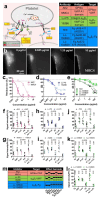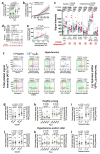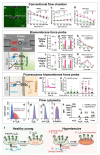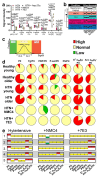This is a preprint.
Multi-parametric thrombus profiling microfluidics detects intensified biomechanical thrombogenesis associated with hypertension and aging
- PMID: 38915705
- PMCID: PMC11195082
- DOI: 10.1101/2024.06.11.598290
Multi-parametric thrombus profiling microfluidics detects intensified biomechanical thrombogenesis associated with hypertension and aging
Update in
-
Multi-parametric thrombus profiling microfluidics detects intensified biomechanical thrombogenesis associated with hypertension and aging.Nat Commun. 2024 Oct 21;15(1):9067. doi: 10.1038/s41467-024-53069-9. Nat Commun. 2024. PMID: 39433750 Free PMC article.
Abstract
Arterial thrombosis, which represents a critical complication of cardiovascular diseases, is a leading cause of death and disability worldwide with no effective bioassay for clinical prediction. As a symbolic feature of arterial thrombosis, severe stenosis in the blood vessel creates a high-shear, high-gradient flow environment that effectively facilitates platelet aggregation towards vessel occlusion even with platelet amplification loops inhibited. However, no approach is currently available to comprehensively characterize the size, composition and platelet activation status of thrombi forming under this biorheological condition. Here, we present a thrombus profiling assay that monitors the multi-dimensional attributes of thrombi forming in conditions mimicking the physiological scenario of arterial thrombosis. Using this platform, we demonstrate that different receptor-ligand interactions contribute distinctively to the composition and activation status of the thrombus. Our investigation into hypertensive and older individuals reveals intensified biomechanical thrombogenesis and multi-dimensional thrombus profile abnormalities, demonstrating a direct contribution of mechanobiology to arterial thrombosis and endorsing the diagnostic potential of the assay. Furthermore, we identify the hyperactivity of GPIbα-integrin αIIbβ3 mechanosensing axis as a molecular mechanism that contributes to hypertension-associated arterial thrombosis. By studying the interactions between anti-thrombotic inhibitors and hypertension, and the inter-individual variability in personal thrombus profiles, our work reveals a critical need for personalized anti-thrombotic drug selection that accommodates each patient's pathological profile.
Conflict of interest statement
Competing interests: Authors declare that they have no competing interests.
Figures






References
Publication types
Grants and funding
LinkOut - more resources
Full Text Sources
Research Materials
